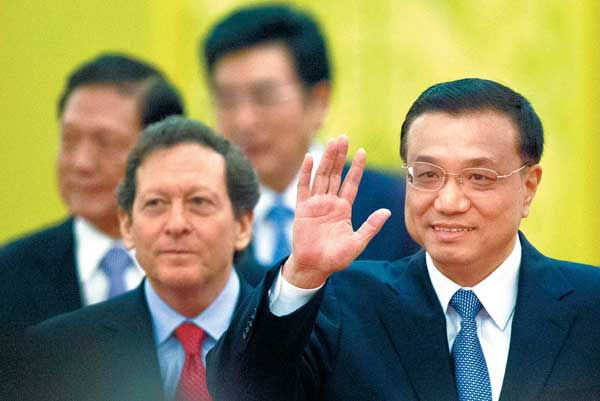 Vice-Premier Li Keqiang attends the award ceremony for the Pritzker Architecture Prize, one of the field's top prizes, in Beijing on Friday. ?[Photo by Alexander Yuan / Associated Press] |
Three months after Chinese architect Wang Shu was named the country's first Pritzker Architecture Prize laureate, he formally received the award from Vice-Premier Li Keqiang on Friday at the Great Hall of the People in Beijing.
It was the first time that the award, often referred to as "architecture's Nobel Prize", was presented in China. Every year, usually in May, the presentation ceremony moves around the world to pay homage to the architecture of other times or to works by previous laureates of the prize. Two years ago, Beijing was chosen as the site for this year’s ceremony.
The selection of Beijing is a sign of the international approval Chinese architecture has won, Li said.
"As the carrier of history and culture, architecture reflects China’s national image. Chinese architecture has to not only maintain its national characteristics but also to absorb advanced technologies globally. Promoting international cooperation is beneficial for the development of Chinese architecture," Li noted.
Founded by the Hyatt Foundation in 1979, the Pritzker Architecture Prize is awarded each year to a living architect whose architectural work demonstrates a combination of talent, vision and commitment.
The jury citation said Wang was selected because his work opens new horizons and at the same time resonates in people's memories. His buildings have the unique ability to evoke the past without making direct references to history. The members of the jury included some of the most renowned architects in the world, such as Zaha Hadid and Glenn Murcutt.
Wang’s signature designs include the Library of Wenzheng College at Suzhou University, Ningbo History Museum and the Xiangshan Campus of the China Academy of Art.
All these works have integrated function with the buildings' surroundings. Buildings should accommodate the connections among people, Wang has said, citing the example of the Xiangshan campus, for which he widened the buildings' corridors, did away with many doors and built pavilions.
"I was thinking of the college where Confucius studied and Greek philosophers chatted with fellow students. In this way, a campus dissolves boundaries and people can easily find one another and enjoy talking in open spaces."
Wang’s concerned look into modern architecture's relationship with people and traditional culture is, in the eyes of Hyatt Foundation chairman Thomas J. Pritzker, a guideline for the future of urbanization.
"This urbanization, like urbanization around the world, needs to be in harmony with local needs and culture. China's unprecedented opportunities for urban planning and design will want to be in harmony with both its long and unique traditions of the past and with its future needs for sustainable development," he said.
Wu Yiyao in Shanghai contributed to this story.
Contact the writer at hanbingbin@chinadaily.com.cn.
